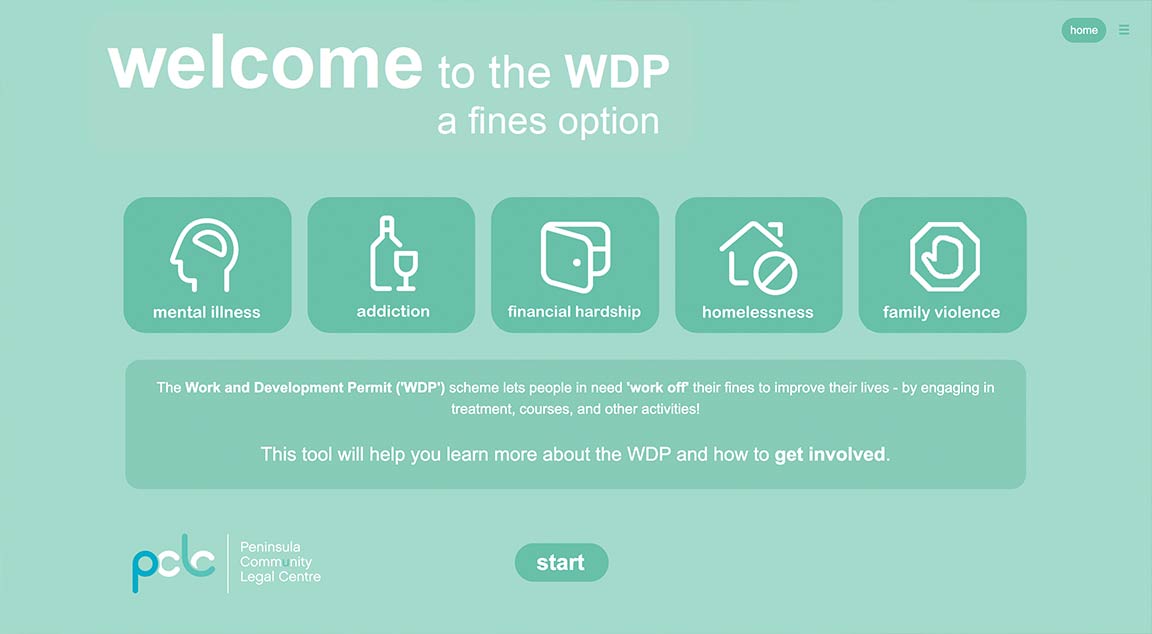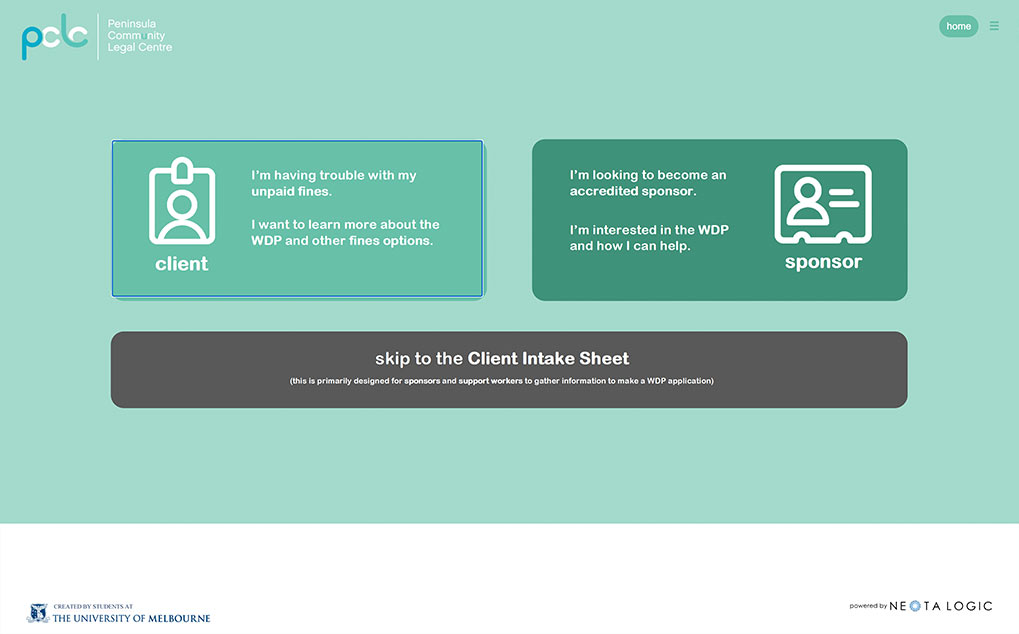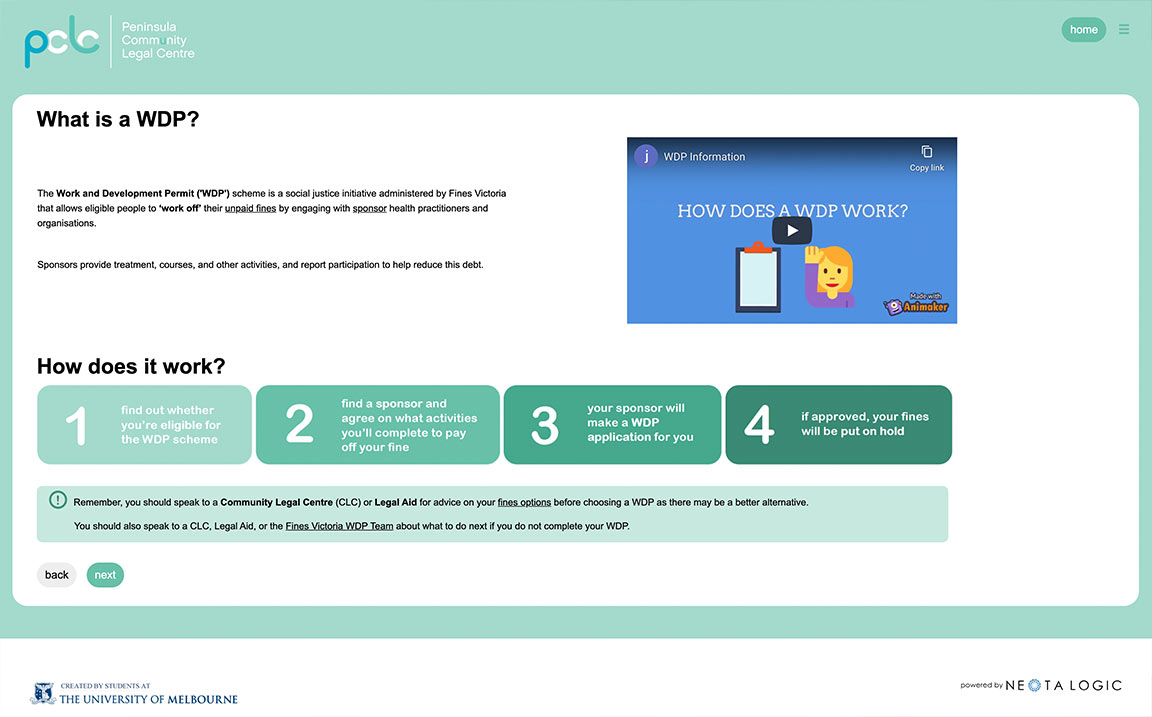Law Apps 2020: Combining law and technology
A group of MLS students have used creative thinking to develop an app that will help some of Australia’s most vulnerable people pay outstanding fines.

In the Law Apps JD course taught by Associate Professor Gary Cazalet, teams of students are partnered with external organisations and tasked with designing, building and releasing an app that can provide legal information to non-lawyers.
This year one student team comprising Carol Wu, Rachel Ruan, Joseph Li, Emily Vrech and Jasmine Xu worked with Peninsula Community Legal Centre (PCLC), a not-for-profit organisation that provides free legal services to disadvantaged people, to develop a solution for making legal information more accessible to vulnerable people who are unable to pay their fines. The app 'Welcome to the WDP' was recently launched and is now being used by PCLC.
The project centred around the Victoria State Government’s Work and Development Permit (WDP) scheme, which provides a non-financial way for people to work off their fines.
Increasing accessibility
Joseph Li says one of the key issues surrounding the WDP scheme was a lack of awareness, especially for vulnerable people who have fines. “Even if people were aware of the scheme, there may have been a lack of understanding about how to progress through it,” he says.
One of the aims of our app was to condense that information and make it more accessible for clients so that more people can actually use the scheme.
After meeting with PCLC to find out what their needs were for the app, the team mapped out the app and planned how it would work in practice.

Welcome to the WDP: Users of the app can learn more about the program, and how it applies to their specific situations
Rachel Ruan says “We figured out that the app would be used primarily by the project worker who does most of the outreach for the WDP scheme. We thought, ‘what would she or he need to make their outreach work smoother and easier’?”
The team identified a three-way structure that split the app into three ‘branches’ – a client-facing branch, a backend branch for PCLC staff, and one for potential sponsors who might be interested in participating in the program.
The team faced some challenges along the way, including not being able to meet in person or meet with their user testers due to COVID-19. The project also necessitated new ways of thinking for the law students.
Carol Wu, who led the design side of the project, says “As law students with no prior coding or graphic design backgrounds, it was quite challenging coming up with ideas and then executing them in a way that we were happy with.”
Using the no-code automation platform Neota Logic and principles of human-centred design, the team was able to surmount these challenges and develop a sophisticated app that met their client’s brief.

Using the no-code automation platform Neota Logic, students created an app that is sophisticated and functional
A different way of thinking
Reflecting on what she gained from the course, Rachel says “I really liked the fact that structuring and building the app forced me to use very different logic. It made me think in a way that made things as simple as possible so the app was user friendly.”
Joseph says “This subject is unique in that it’s completely different from your traditional black letter law subjects – it definitely lent itself to us thinking more creatively, and it was interesting to see how you can transform legal services using technology.”
Now that the app has been tested and launched, Emily says “It feels really good – the sense of achievement you get out of completing the app and working within a team to do it. Law Apps was a labour-intensive course but the opportunity you get to make something meaningful that could make a difference is pretty unique.”
“Seeing how far we’ve come from the start of the semester, not knowing anything about app making or coding or human-centred design, to having a functional app that’s distributed among community legal centres, is really satisfying,” says Carol.
Kirsten Young, PCLC’s Community Engagement Officer, says the students had a lot of creative and substantive input to the app and not only met the brief, but exceeded it.
We gave the students a brief but they came up with a lot of the key features of the app. We were really impressed with the ideas they had in terms of making it more creative and more practically useful.
“We’ve user tested the app with a government department and other community organisations and the feedback has been really positive.”
Making a positive impact
Ms Young says working with the students was a fantastic experience. “They were right across the subject matter, they were very responsive, and even after the course had finished they still continued to make refinements to the app. They’re pretty dedicated.”
With the app now launched, Ms Young believes it will make a positive impact on the lives of vulnerable Australians.

The simple layout and user-friendly design of the app will help increase understanding about the WDP program
“Nobody likes getting a fine, but fines affect disadvantaged people disproportionately – for instance homeless people, refugees, and students. And with COVID-19 you have much larger fines now, which are even more difficult to pay.
It’s a fairly complicated process to get into the WDP scheme, and what this app does is smooth the way into this really beneficial program for a vulnerable cohort of people who can’t pay their fines.
Ms Young says the Law Apps course is fantastic for community legal centres like PCLC. “It helps us to have these digital tools that we could never develop commercially, and the quality is incredibly high. It helps community legal centres and other organisations to increase vulnerable people’s access to justice.”
Associate Professor Gary Cazalet, who leads the Law Apps course, says this project is one of many exciting apps to come out of the course.
“Law Apps brings together skills and approaches which are vital to future legal practice,” he says. “Students learn that curiosity, creativity and collaboration combined with technology can deliver solutions that meet the needs of clients. Students relish the opportunity to bring a wide range of traditionally underutilised personal skills to their projects.”